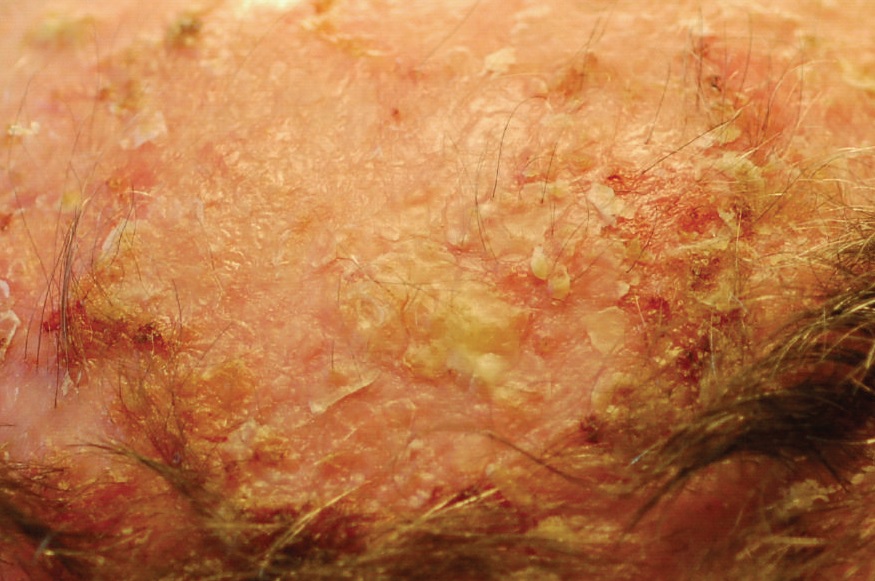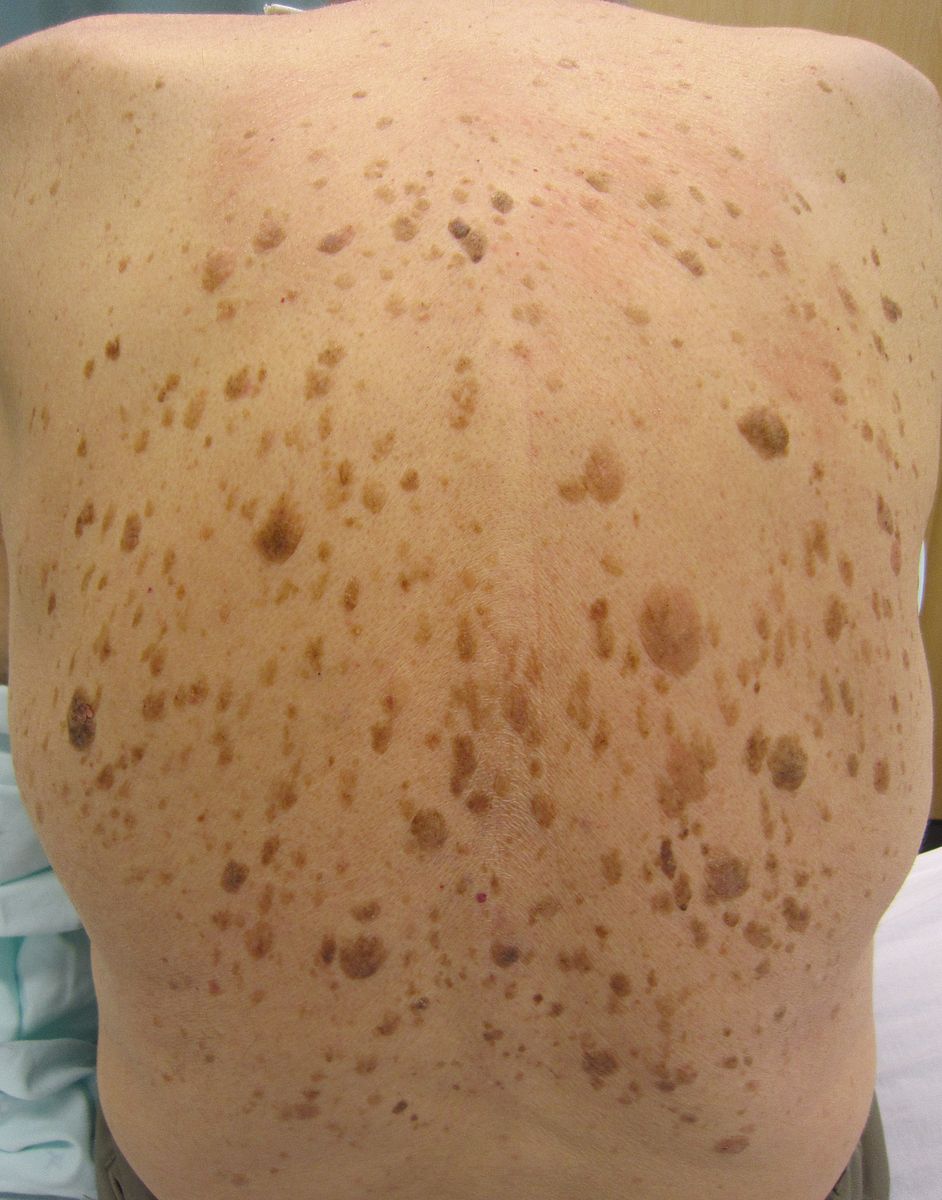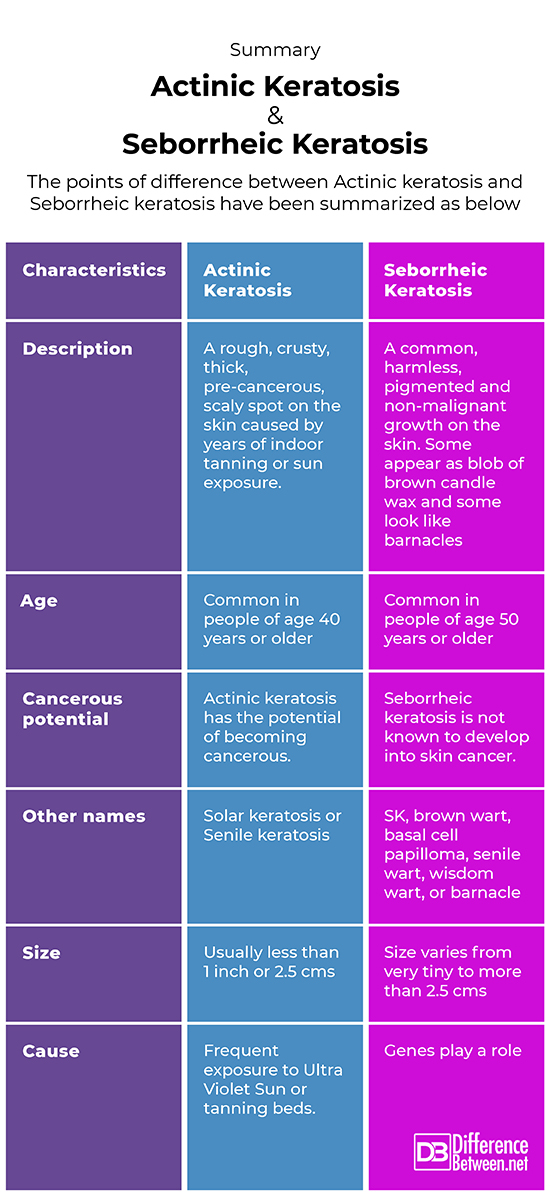Difference Between Actinic Keratosis and Seborrheic Keratosis
What are actinic keratosis and seborrheic keratosis?
Actinic keratosis (solar keratosis) and seborrheic keratosis (senile wart) are two skin conditions that are sometimes confused to be the same medical conditions (skin conditions) because of their similar names, but they’re actually very different.
Actinic keratosis are lesions (lesions could become cancerous) that develop on face, shoulders neck, hands, and arms due to years of exposure to sun’s UV rays. Common in people of age 40 or older. These lesions could develop into skin cancer.
Seborrheic keratosis is condition of skin that results in non-malignant skin lesions. Common in people of age 50 or older. These lesions or skin growths are usually harmless and do not pose any threat to skin health.
Similarity
Both skin conditions are irregular keratin skin growths that develop out of common types of skin cells (keratinocyte cells)

Actinic keratosis
Actinic keratosis or solar ketosis is a scaly, abnormal growth of cells (sometimes cancerous) or patch found on sun-damaged skin.

Seborrheic keratosis
This is a non-cancerous senile wart that appears as black, or waxy brown and tan lesions.
Difference between actinic keratosis and seborrheic keratosis
Description
Scaly cancerous lesions on skin
Seborrheic keratosis
Waxy non-cancerous lesions
Symptoms
Actinic keratosis
- Scaly patch on lips, forearms, neck, ears, lips, forehead, scalp and hands
- In some people, it is a hard and wartlike surface
- Flat to raised patch or bump on the upper most layer of skin
- Lesion takes a long duration of time (years) to develop
- Color variations in the patches, including pink, brown or red
- Burning, itching, bleeding or crusting
Seborrheic keratosis
A seborrheic keratosis:
- Is a condition wherein senile wart of light tan, brown or black color appears on the chest, face, shoulders or back side of the body.
- Have a pasted-on, waxy look
- There could be itching
- The warts are round or oval shaped
- Is elevated or flat with a waxy and scaly surface
- Ranges in size from very tiny to 2.5 cms
Risk factors
Actinic keratosis
Anyone can suffer from actinic keratoses. But there is an increased risk in people who:
- Have red or blond hair
- Have light-coloured or blue eyes
- Lives in a place which gets too much sunlight
- Are above 40 years of age
- Works mostly outdoors
- Possess a past history of having a lot of sunburn or sunlight exposure
- Tend to burn or freckle on being exposed to sunlight
- Have a fragile and weak immune system
Seborrheic keratosis
Anyone can suffer from Seborrheic keratosis. But there is an increased risk in people who:
- Are above 50 years of age
- Family history of the condition or family members with seborrheic keratosis
- Are frequently exposed to sun
Treatment
Actinic keratosis
Recommended treatment for Solar or actinic keratoses may include:
- Topical therapies – Use of medications like Diclofenac gel, 5-aminolevulinic acid, imiquimod cream, tretinoin, ingenol mebutate gel to destroy actinic keratoses lesions.
- Medication – Oral retinoids
- Cryotherapy – It is a “cold therapy,” technique where the body is exposed to extremely cold temperatures for some time. Harmful cells are freezed by application of liquid nitrogen, removed and destroyed.
- Curettage – Minor surgical scraping in which a scalpel (a small straight thin-bladed knife) is used to remove the pre-cancerous or cancerous growth
- Photodynamic therapy (PDT) – is a 2-stage procedure in which a chemical is applied in combination with a specific light to remove the malignant and pre-malignant cells after light activation.
- Electrocautery – cautery (removal of diseased cells) using an instrument that is electrically heated.
- Laser ablation – Use of laser to remove unwanted and diseased tissues
- Chemical peels and dermabrasions (the removal of superficial layers of skin with a rapidly revolving abrasive tool)
Seborrheic keratosis
Usually, there is no recommended treatment for seborrheic keratoses as the lesions are mostly non-cancerous. These lesions usually do not cause any pain, discomfort. However, if these cause any concerns like patient feels uncomfortable with the appearance, or lesions bleed, irritate or are inflamed, then some treatment options are available which include;
- Cryosurgery – Highly effective treatment where application of extreme cold in surgery from liquid nitrogen takes place to destroy diseased or the abnormal skin tissues
- Curettage – Minor surgical scraping in which a scalpel (a small straight thin-bladed knife) is used to remove the growth
- Electrocautery – also called electrocautery, is a procedure in which cautery is carried out using uses heat from an electric current (direct or alternating current) to remove the unwanted or harmful tissue
- Laser ablation – or photoablation is a procedure in which laser flux is used to destroy the lesions
- Topical therapy – Medication in which Hydrogen Peroxide is used to shrink the diseased cells.
Summary
The points of difference between Actinic keratosis and Seborrheic keratosis have been summarized as below:

- Difference Between Global Warming and Greenhouse Effect - May 18, 2024
- Difference Between Vaccination and Immunization - March 3, 2024
- Difference Between Selective Mutism and Autism - February 25, 2024
Search DifferenceBetween.net :
Leave a Response
References :
[0]Goldenberg, G., & Perl, M. (2014). Actinic keratosis: update on field therapy. The Journal of clinical and aesthetic dermatology, 7(10), 28.
[1]Hafner, C., & Vogt, T. (2008). Seborrheic keratosis. JDDG: Journal der Deutschen Dermatologischen Gesellschaft, 6(8), 664-677.
[2]Jackson, J. M., Alexis, A., Berman, B., Berson, D. S., Taylor, S., & Weiss, J. S. (2015). Current understanding of seborrheic keratosis: prevalence, etiology, clinical presentation, diagnosis, and management. Journal of drugs in dermatology: JDD, 14(10), 1119-1125.
[3]Siegel, J. A., Korgavkar, K., & Weinstock, M. A. (2017). Current perspective on actinic keratosis: a review. British Journal of Dermatology, 177(2), 350-358.
[4]Image credit: https://commons.wikimedia.org/wiki/File:Seborrheic_keratosis_on_human_back.jpg
[5]Image credit: https://commons.wikimedia.org/wiki/File:Actinic_keratosis_of_the_scalp.jpg
